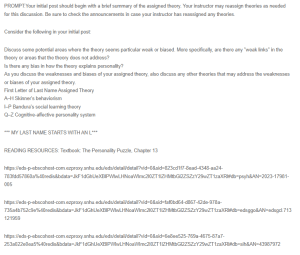Discussion Responses – Weaknesses and Biases
Responding to Savannah
Hello,
Your post is very insightful. The cognitive personality theory has some weaknesses and biases that could affect how it is used in psychology. The weaknesses and biases discussed in your post such as the theory’s reliance on the idea of personality which is consistently expressed through behavioural patterns in situations leading to the ignorance that there may be internal factors that affect personality is similar to the weaknesses and biases I identified when I was reviewing the theory. However, I also found that the theory ignores the significance of constant personality traits that are not changed by situations and only focuses on situational factor which could result in the assumption that personality is not consistent.
The weaknesses and biases identified above can be addressed using the Big Five Personality Theory. The theory breaks down personality into five components which include extraversion, agreeableness, conscientiousness, neuroticism, and openness (Soto,2018). The Big Five theory can address the weaknesses and biases of the cognitive personality theory because it offers a detailed review of personality by considering all aspects of human personality including the personalities influenced by situations.
References
Soto, C. J. (2018). Big Five personality traits. In M. H. Bornstein, M. E. Arterberry, K. L.
Fingerman, & J. E. Lansford (Eds.), The SAGE Encyclopedia of Lifespan human
Development (pp. 240-241). Thousand Oaks, CA: Sage
Responding to Adalia
Hello,
This is a great post. Analysis of the operant conditioning theory provided similar findings on the theory’s weaknesses and biases by revealing the theory’s failure to factor in the internal processes that shape behaviour. However, I also found that the theory’s assumption that behaviour is only shaped by external factors could create a bias towards the factors that shape human behaviour because it fails to consider internal factors such as the person’s thinking process.
The weaknesses and biases of the social cognitive theory identified above can be addressed using the social cognitive theory. According to Usher and Ford (2022) the social cognitive theory states that human behaviour is developed through social interactions. Therefore, the social cognitive theory can be applied to understand the link between a person’s environment and their behaviour without overreliance on external factors used in operant conditioning because it recognizes the importance of personal beliefs, self-regulation and cognitive processes in behaviour.
References
Usher, E., & Ford, C. J. (2022). Social cognitive theory and personal agency. Social Cognitive Theory and Personal Agency. https://doi.org/10.4324/9781138609877-ree48-1
ORDER A PLAGIARISM-FREE PAPER HERE
We’ll write everything from scratch
Question
PROMPT:Your initial post should begin with a brief summary of the assigned theory. Your instructor may reassign theories as needed for this discussion. Be sure to check the announcements in case your instructor has reassigned any theories.

Discussion Responses – Weaknesses and Biases
Consider the following in your initial post:
Discuss some potential areas where the theory seems particular weak or biased. More specifically, are there any “weak links” in the theory or areas that the theory does not address?
Is there any bias in how the theory explains personality?
As you discuss the weaknesses and biases of your assigned theory, also discuss any other theories that may address the weaknesses or biases of your assigned theory.
First Letter of Last Name Assigned Theory
A–H Skinner’s behaviorism
I–P Bandura’s social learning theory
Q–Z Cognitive-affective personality system
*** MY LAST NAME STARTS WITH AN L***
READING RESOURCES: Textbook: The Personality Puzzle, Chapter 13

